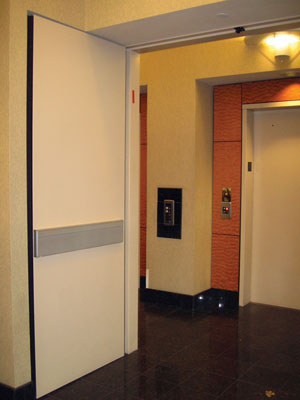Design Alternatives to the Enclosed Elevator Lobby: Fire and Smoke Safety Solutions
Despite the combination of active and passive fire containment techniques written into the building code, smoke migration has continued to be a dangerous and deadly aspect of building fires. Over the past decade, the IBC has recognized the need to better contain the spread of smoke in a multi-story building and has begun requiring that buildings also be equipped with smoke protection for horizontal assemblies, in addition to the active and passive fire containment systems already described.
Today, the IBC mandates smoke protection in several different areas throughout a multi-story building. Smoke protection is required at the elevator shaft, in areas of refuge, to separate an atrium from the rest of the building, and wherever a fire and smoke rated wall has been opened up to provide access or counter space. Additionally, smoke protection needs to be added to most multi-story historical renovations to bring the existing building into compliance with current fire and life safety codes which require both vertical and horizontal barriers that may not have been in place originally.
Smoke and Fire in the Elevator Shaft
 |
Section 707.14.1 of the 2006 IBC prescribes that design teams incorporate a fire-rated, enclosed elevator lobby at the elevator shaft. The code also identifies seven exceptions to this rule. Photo courtesy of Smoke Guard, Inc. |
Elevator shafts act like chimneys in multi-story buildings enabling large quantities of air to move from floor to floor and, when a fire occurs, acting as a conduit transporting smoke throughout a building. The heated smoke enters the elevator shaft from the fire floor and rises, displacing the resident cooler, denser air. Stack effect pressures in the elevator hoistway draw this cool smoke up through the vertical shaft. As the smoke rises, it easily leaks back through the elevator doors and onto other floors, spreading quickly beyond its point of origination and exposing occupants on upper floors to this dangerous and toxic hazard. Despite design teams' best efforts to compartmentalize, the vertical elevator shaft compromises each floor and must be specifically addressed to provide fire, smoke, and life safety in the built environment.
IBC Requires an Enclosed Elevator Lobby -
or Something Better
Where three or more stories are connected by an elevator shaft, architects are required, by the IBC, to isolate each floor from the elevator shaft with both fire and smoke protection. In IBC 2009 Section 708.14.1 (IBC 2012 713.14.1), the IBC prescribes in its charging language that design teams incorporate a fire-rated, enclosed elevator lobby onto each floor to provide the requisite separation. As the name may suggest, an enclosed elevator lobby is a room that is built around the elevator doors that can be closed off from the rest of the floor in the event of a fire. The code mandates, in Section 708, that the fire partitions shall have a fire rating of not less than one hour and, in accordance with Section 715, that the openings in fire partitions must be protected by an opening protective with a minimum of a 20 minute fire rating. Simply put: the enclosed elevator lobby must be constructed with walls that have a one hour fire rating and doors that have a 20 minute fire rating, as a minimum.
Beyond the requisite fire rating, it is also mandated in the IBC that the corridor walls and doors in them shall resist the passage of smoke. The code contains the construction requirements for creating wall assemblies that are capable of restricting the movement of smoke from one side of the wall to the other. The doors or opening protectives must meet the air leakage performance outlined by the Underwriters Laboratories (UL) 1784 test. These air leakage tests of door assemblies examine the rate that air and smoke leak from one side of the door to the other and establish that particular door assemblies appropriately resist the spread of smoke.
In order to meet the fire and smoke protection requirements, architects commonly specify fire-rated swing doors with gaskets as the doors used to enclose a lobby. When the swing doors close, the gasket fills in the empty space between the door and the frame, creating a seal to prevent smoke from leaking out of the vestibule. This lobby becomes a barrier on the fire floor keeping smoke from penetrating the elevator shaft and, simultaneously, prevents smoke from migrating out of the elevator shaft onto a non-fire floor.
While enclosed elevator lobbies are the code-prescribed solution for maintaining fire, smoke, and life safety at the elevator shaft, they are often far from ideal in terms of how they can impact an architect's designs. In some buildings, like a standard office tower, elevator lobbies are naturally created amidst a bank of elevators, which makes the vestibule easy to incorporate into the space. However, in building types that are more complex, or that have design intentions that significantly differ from the standard office tower, the vestibule solution can create a real challenge for an architect trying to figure out how to incorporate enclosed lobbies into the design. Additionally, it can be a challenge to create a vestibule that feels open and continuous with the rest of the building.









